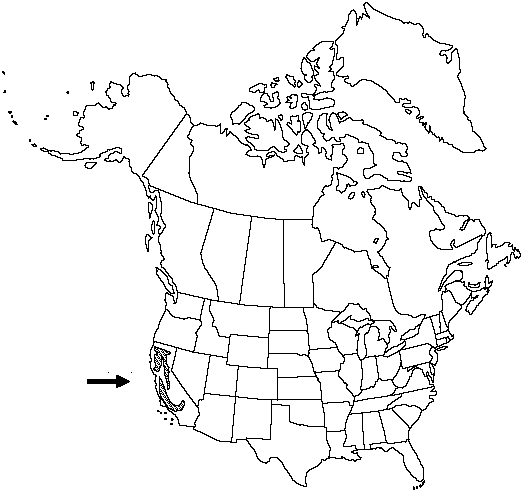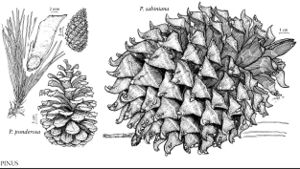Pinus sabiniana
in A. B. Lambert, Descr. Pinus [ed. 3] 2: unnumbered page between 144 and 145, plate 80. 1832.
Trees to 25m; trunk to 1.2m diam., straight to crooked, often forked; crown conic to raggedly lobed, sparse. Bark dark brown to near black, irregularly and deeply furrowed, ridges irregularly rectangular or blocky, scaly, often breaking away, bases of furrows and underbark orangish. Branches often ascending; cone-bearing branchlets stout, twigs comparatively slender, both pale purple-brown and glaucous, aging gray, rough. Buds ovoid, red-brown, ca. 1cm, resinous; scale margins white-fringed. Leaves mostly 3 per fascicle, drooping, persisting 3–4 years, 15–32cm × 1.5mm, slightly twisted, dull blue-green, all surfaces with pale, narrow stomatal lines, margins serrulate, apex short-acuminate; sheath to 2.4cm, base persistent. Pollen cones ellipsoid, 10–15mm, yellow. Seed cones maturing in 2 years, shedding seeds soon thereafter, persisting to 7 years, pendent, massive, heavy, nearly symmetric, ovoid before opening, broadly to narrowly ovoid or ovoid-cylindric when open, 15–25cm, dull brown, resinous, stalks to 5cm; apophyses elongate, curved, continuous with umbos to form long, upcurved claws to 2cm. Seeds narrowly obovoid; body ca. 20mm, dark brown; wing broad, short, ca. 10mm. 2n = 24.
Habitat: Dry foothills on the west slope of the Sierra Nevada, and in the coast ranges, nearly ringing the Central Valley of California
Elevation: 30–1900m
Distribution

Calif.
Discussion
Seeds of Pinus sabiniana were an important food source for many Indian groups in California, sometimes collectively referred to as "Digger Indians." Because the name "Digger" has been used as a derogatory ethnic term, many people prefer to avoid using the vernacular name Digger pine.
